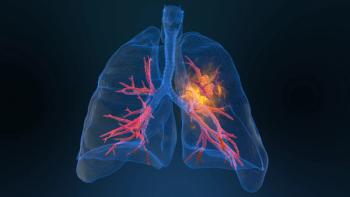
Interstitial Lung Abnormalities in Patients With COPD Linked to Cancer, Heart Failure Risks
Key Takeaways
- ILAs in patients with COPD are associated with lower lung cancer incidence but higher prevalence of other cancers and heart failure.
- Patients with ILAs showed significantly lower fibrinogen and procalcitonin levels compared with those without ILAs.
Interstitial lung abnormalities (ILAs) in patients with chronic obstructive pulmonary disease (COPD) are linked to lower lung adenocarcinoma rates but higher rates of other cancers and heart failure.
Interstitial lung abnormalities (ILAs) are associated with various comorbidities in patients with
Although COPD diagnoses typically rely on patient-reported symptoms and pulmonary function tests, chest computed tomography (CT) imaging is often
Chest CT scans can also
Despite the well-established relationship between ILA and respiratory morbidities, its correlation with non-respiratory comorbidities remains unexplored. Consequently, the researchers aimed to assess the association between the presence of ILA in patients with COPD and their comorbidities, along with their clinical and laboratory characteristics.
They examined a retrospective cohort of patients hospitalized with COPD at the First Affiliated Hospital of Xiamen University. Eligible patients were those diagnosed with COPD according to the Global Initiative for Chronic Obstructive Lung Disease (GOLD) criteria and were hospitalized between January 2015 and August 2021.
The researchers extracted all data on eligible patients from their medical records. Next, they classified patients based on the presence or absence of ILA. Then, the researchers performed analyses to identify differences in demographic characteristics, clinical profiles, laboratory results, and comorbid conditions between the 2 groups.
The study population consisted of 1131 hospitalized patients with COPD, with males comprising 93.7%. Of these patients, 82.3% were hospitalized due to acute exacerbations, and 60% had respiratory infections; the median hospitalization duration was 8 days. Additionally, 85.6% (n = 962) had emphysema, and 14.6% (n = 165) exhibited ILAs. The 3 most prevalent comorbidities were lung cancer (19.3%), history of tuberculosis (12.7%), and coronary artery disease (9.9%).
After stratifying the study population into groups based on ILA presence, the researchers noted no statistically significant differences in clinical, demographic, or laboratory parameters. However, the one exception was circulating fibrinogen (FIB) and procalcitonin (PCT) levels. Compared with those without ILA, patients with ILA displayed significantly lower levels of FIB (3.82 g/L vs 4.34 g/L; P = .018) and PCT (0.046 ng/mL vs 0.064 ng/mL; P = .005).
Similarly, the researchers found significant differences in the prevalence of several comorbid conditions among patients with and without ILA. In particular, the incidence of lung cancer among those with ILA was about half that of those without ILA (11.5% vs 20.6%; OR, 0.50; 95% CI, 0.30-0.83; P = .006).
Of those with comorbid lung cancer, 198 were diagnosed during hospitalization, and 20 had a prior diagnosis. The researchers found that 8.6% (n = 17) of the patients diagnosed during hospitalization also had an ILA, a rate comparable to that observed in the group diagnosed before hospitalization (10%). Additionally, they further examined the association of ILA with 3 major lung cancer subtypes: adenocarcinoma (ADC), squamous cell carcinoma (SCC), and other lung cancers.
Compared with those without comorbid lung cancer, those with lung ADC exhibited a significantly lower ILA prevalence (OR, 0.32; 95% CI, 0.15-0.71; P = .005). The researchers found a similar trend among patients with COPD and comorbid lung SCC (OR, 0.48; 95% CI, 0.22-1.11; P = .09); however, this was not statistically significant. Conversely, the prevalence of ILA in patients with other lung cancer subtypes was comparable to that in patients without lung cancer.
Lastly, the researchers found that the prevalence of cancers other than lung cancers in the ILA group was significantly higher than in the non-ILA group (7.9% vs 3.6%; OR, 2.27; 95% CI, 1.16-4.39; P = .012). Similarly, they discovered heart failure was more prevalent in the ILA group (11.5% vs 6.9%; OR, 1.75; 95% CI, 1.04-3.00; P = .04).
The researchers acknowledged their limitations, including the study population consisting solely of hospitalized patients with COPD, potentially limiting the generalization of their findings. Because of the male predominance among smokers in China, most patients were male, meaning these findings may not be generalizable to female patients. However, they expressed confidence in their findings and suggested areas for further research.
“...our study demonstrates that the presence of ILA in patients with COPD is associated with multiple comorbidities of the disease, particularly lung ADC,” the authors concluded. “Further investigations are warranted to better understand these relationships and their clinical implications.”
References
- Zheng J, Guo J, Wang G, et al. Interstitial lung abnormality in COPD is inversely associated with the comorbidity of lung cancer. BMC Pulm Med. 2024;24(1):506. doi:10.1186/s12890-024-03311-3
- Ostridge K, Wilkinson TM. Present and future utility of computed tomography scanning in the assessment and management of COPD. Eur Respir J. 2016;48(1):216-228. doi:10.1183/13993003.00041-2016
- Brown JP, Martinez CH. Chronic obstructive pulmonary disease comorbidities. Curr OpinPulm Med. 2016;22(2):113-118. doi:10.1097/MCP.0000000000000241
- Hata A, Schiebler ML, Lynch DA, Hatabu H. Interstitial lung abnormalities: state of the art. Radiology. 2021;301(1):19-34. doi:10.1148/radiol.2021204367
Newsletter
Stay ahead of policy, cost, and value—subscribe to AJMC for expert insights at the intersection of clinical care and health economics.















































